Chapter: The Diversity of Fishes: Biology, Evolution, and Ecology: Teleosts at last II:spiny-rayed fishes
Suborder Percoidea
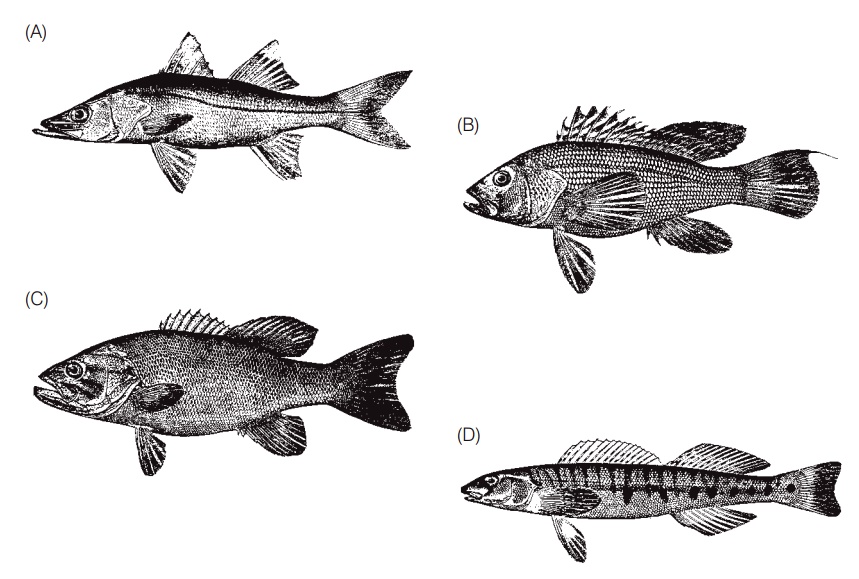
Suborder Percoidea
The largest perciform suborder is the Percoidei, containing 78 families and 3176 species (Fig. 15.9). Percoids, incontrast with lower teleosts such as ostariophysans and protacanthopterygians (and continuing trends in acanthopterygians and percomorphs), are characterized by: (i) the presence of spines in the dorsal, anal, and pelvic fins; (ii)two dorsal fins (never an adipose fin); (iii) ctenoid scales;(iv) pelvic fins in the abdominal position; (v) laterally placedand vertically oriented pectoral fins; (vi) maxilla excludedfrom the gape; (vii) physoclistous gas bladder; (viii) absence of orbitosphenoid, mesocoracoid, epipleural, and epicentralbones; (ix) acellular bone; and (x) never more than 17 principal caudal fin rays.
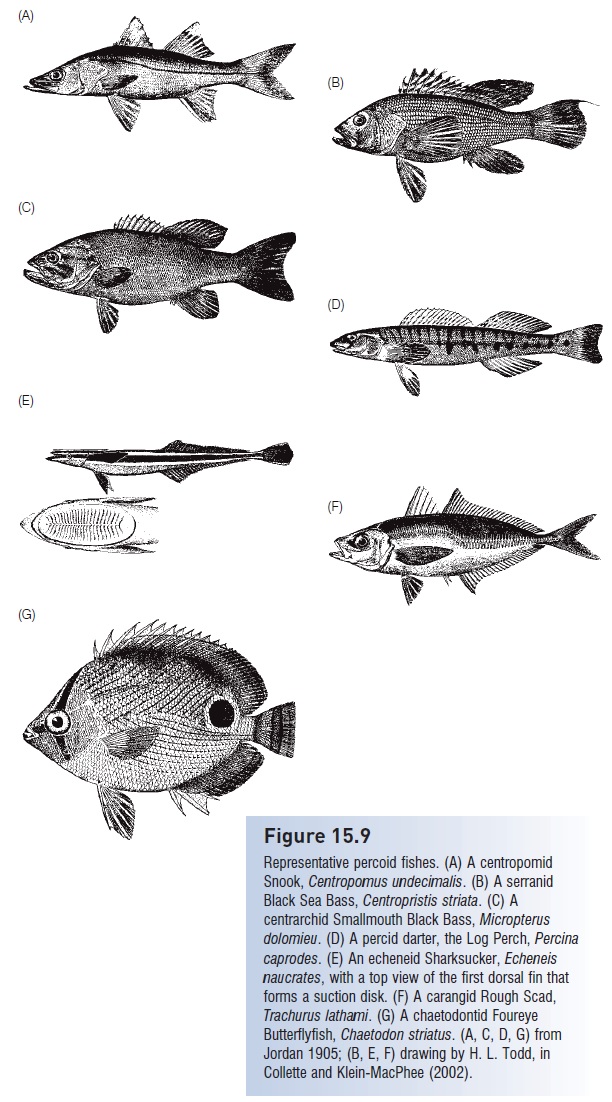
Figure 15.9
Representative percoid fishes. (A) A centropomidSnook, Centropomus undecimalis. (B) A serranidBlack Sea Bass, Centropristis striata. (C) Acentrarchid Smallmouth Black Bass, Micropterusdolomieu. (D) A percid darter, the Log Perch, Percinacaprodes. (E) An echeneid Sharksucker, Echeneisnaucrates, with a top view of the first dorsal fin thatforms a suction disk. (F) A carangid Rough Scad, Trachurus lathami. (G) A chaetodontid FoureyeButterflyfish,Chaetodon striatus. (A, C, D, G) fromJordan 1905; (B, E, F) drawing by H. L. Todd, inCollette and Klein-MacPhee (2002).
The basal families of percoids are what would generallybe considered basslike fishes. Centropomids are primarilylarge, pisicivorous fishes of lakes, estuaries, and nearshore regions, including the snooks (Centropomus) of tropicalAmerica. Related latids include the Barramundi of Australia and Nile Perch of Africa (Lates spp.). Nile Perch and their relatives have been widely introduced in African lakes and have caused decimation of native endemic cichlids (see Species introductions). The moronid temperatebasses include lake-dwelling and anadromous predators in North America such as the White Bass and Striped Bass(Morone spp.). The closely relatedpolyprionid wreckfishes include such commercially important species as the Atlantic Wreckfish (Polyprion americanus) and the Giant Sea Bass ofCalifornia (Stereolepis gigas), the latter reaching lengths of 2 m and weighing up to 250 kg. The seabass familySerranidaecontains 475 species and is one of the largest fish families(as many as 15 subfamilies have been variously recognized).It contains a tremendous diversity of sizes and shapes offishes that have three spines on the opercle but may differ in many other characters. Serranids vary in size from 3 cm long planktivorous anthiines to the 3 m long, 400 kg Goliath Grouper, Epinephelus itajara, which eats lobsters and small turtles as well as fishes. Three subfamilies are currently recognized,the first two (Serraninae and Anthiinae) consistingof mostly small forms such as hamlets, sand perches, and the colorful Anthias. The subfamily Epinephelinae is defined bylong, stout or filamentous dorsal and/or pelvic fin spines inthe larvae (see Larval morphology and taxonomy).It contains most commercially important species suchas groupers, hinds, coneys, gag, and scamp but also includes diminutive and striking basslets and the chemically protectedsoapfishes (e.g., Rypticus, Grammistes) which exudea soaplike toxin from their skin when disturbed. Many serranidsare hermaphroditic, usually starting as female and then later becoming male (proto gyny), although some hamlets and members of the genus Serranus function simultaneouslyas either sex. Sex change and easily located, traditionalspawning aggregations have led to massive over fishing of many large serranids (e.g., Nassau Grouper, Epinephelusstriatus), prompting the need for highly regulated fisheries(Beets & Friedlander 1999). To confuse the taxonomic issue,most species known as basslets belong to the related family Grammatidae, which also includes the neon-colored Royal Gramma that lives under ledges in the Caribbean and ispopular among divers and aquarists.
Two important percomorph families in North American fresh waters are the centrarchids and the percids. The Centrarchidae contain 31 species, including the numeroussunfishes, crappies, and rockbasses (Lepomis, Pomoxis, Ambloplites) as well as the seven black basses in the genus Micropterus (e.g., Largemouth, Smallmouth, etc., plusundescribed species in the southeastern USA). Centrarchidsare the dominant carnivores in most lakes in the USA and southern Canada and are also known for their nesting behavior, the males digging and defending circular nests on the bottom through much of the summer. Centrarchids arenative to the region east of the Rocky Mountains with the exception of the Sacramento Perch, Archoplites interruptus,a California endemic with a shrinking native range (Moyle2002). Centrarchids have been widely introduced elsewhere,so widely and successfully that their importation is now outlawed or severely regulated in several countries(Cowx 1997; Helfman 2007).
The family Percidae is one of the most successful nonostariophysan freshwater families in the world. At least 201 species of percids exist, 187 of which occur in North America. The dominant lake forms are larger species such as the Yellow Perch (Perca fl avescens) and Walleye (Sandervitreus) (Colby 1977; Craig 1987). Yellow Perch have their counterpart in the Eurasian Perch, P. fl uviatilis; three species of Sander pikeperches also occur in Europe (Collette &Banarescu 1977).
North American streams contain at least 184 species of darters, mostly in the genera Percina andEtheostoma (Fig. 15.10). The greatest diversity is in the southeastern USA; Tennessee alone houses 90 darter species.These small, benthic fishes feed primarily on aquatic insect larvae and other invertebrates in fast flowing, clean water where males defend nesting rocks and court females. Duringthe breeding season the males take on color patterns thatrival the brightest poster colors of tropical fishes. Darters are disproportionately imperiled because siltation and other forms of pollution

Figure 15.10
The tangerine darter, Percina aurantiaca, the second largest of thenearly 200 species of darters endemic to North America (c. 18 cm).
The apogonid cardinal fishes are a speciose (c. 273 species) family of small (<10 cm), nocturnal coral reef fishes.Their large eyes, large mouths, distinctly separated dorsalfins (the second with a single spine), deep bodies, and relatively pointed heads distinguish them from most other reeffishes that hover motionlessly just above or in structure.Some cardinal fishes mouth-brood their eggs, the male orfemale being responsible in different species. Many cardinalfishes live in close association with invertebrates and use them as refuges (see Interspecific relations:symbioses). A few Indo-Pacific species enter estuaries, and several New Guinea species are restricted to fresh water.The dramatically colored and narrowly distributed Banggai Cardinalfish, Pterapogon kauderni, was once thought to beextinct in the wild – a very rare occurrence among marinefishes (Fig. 15.11). It has apparently recovered as a result ofcaptive breeding and perhapsinadvertent releases fromaquarium holding facilities (Vagelli & Erdmann 2002). The malacanthidtilefishes are a marine group that inhabits burrows. Sand tilefishes (e.g., Malacanthus) are tropical
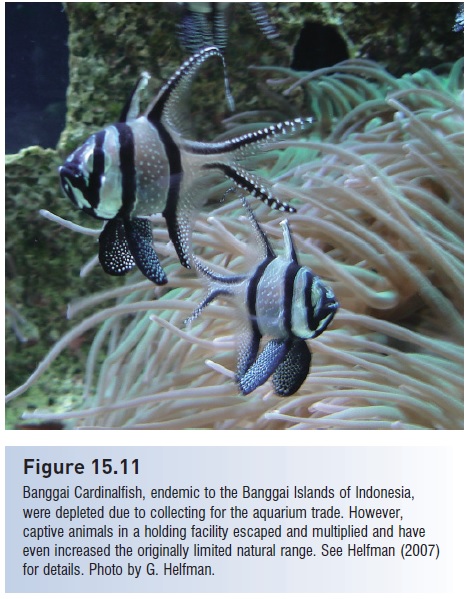
Figure 15.11
Banggai Cardinalfish, endemic to the Banggai Islands of Indonesia,were depleted due to collecting for the aquarium trade. However,captive animals in a holding facility escaped and multiplied and haveeven increased the originally limited natural range. See Helfman (2007)for details. Photo by G. Helfman.
Their engineering activities create hard bottompatches that are used by small fishes and invertebrates thatwould otherwise not colonize sandy regions (see Fishes as producers and transporters of sand, coral, and rocks). The larger temperate latiline tilefishes (e.g., Caulolatilus)are commercially sought species that inhabit largeburrows in deeper soft bottom regions, although it is unknown whether they construct the holes themselves.
The next dozen or so percomorph families (lactariidsthrough caristiids) are generally active, marine, watercolumn dwellers with relatively compressed, often silvery bodies. The larger species are piscivores and the smallerones are zooplanktivores. Lactariid false trevallies anddinolestid long-finned pikes have converged on the body shapes and habits of predatory jacks and barracudas, respectively.The cosmopolitan pomatomid Bluefish, Pomatomussaltatrix, which occurs in most major ocean basins except the eastern Pacific, has a well-deserved reputation for voraciousness(see Hersey 1988). This aggregating predator will enter a school of prey fish and slash and dismember farmore individuals than are actually eaten; attacks on humans unfortunate or foolish enough to be in the water during such feeding frenzies are well documented. The familyNematistiidae is sometimes combined with the next fourfamilies (dolphinfishes, cobia, remoras, and jacks) to form a clade known as carangoids. The colorful Roosterfish, Nematistius pectoralis, is a monotypic piscivore of warm,eastern Pacific, inshore areas. It looks like an amberjack with a cockscomb of seven elongate dorsal spines. It is actively sought as a gamefish and attains lengths of 1.5 mand can weigh 50 kg. The coryphaeniddolphinfishes ormahimahis include two species of open water, surface oriented predators that are often found in association with floating structure or seen chasing flyingfishes. Male Dolphinfish (bulls) have a square head profile involving expansion of the bony portion of the supraoccipital region(forehead) (Fig. 15.12), whereas in females the forehead slopes more gradually; such obvious skeletal sexual dimorphismis rare in acanthopterygians. The golden coloration of corphyphaenids has earned them the Spanish name dorado and their color-changing habits when brought on board a boat are legendary; Yann Martel in Life of Pi likenssubduing a mahimahi with a club as “beating a rainbow to death” (Martel 2003, p. 185).
The monotypic Cobia, Rachycentron canadum (Rachycentridae),looks and swims like a large (up to 1.5 m) remora without a suction disk. Sportfishers frequentlylocate cobia by fishing near manta rays, but the nature of the association is unexplored. The echeneidremoras orsharksuckers are a highly specialized group of eight percomorphsin which the first dorsal fin has been modified into a sucking organ for attachment to sharks, billfishes, whales,
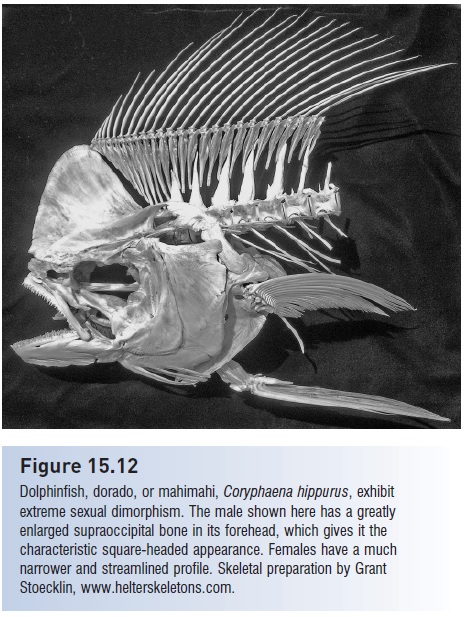
Figure 15.12
Dolphinfish, dorado, or mahimahi, Coryphaena hippurus, exhibitextreme sexual dimorphism. The male shown here has a greatlyenlarged supraoccipital bone in its forehead, which gives it thecharacteristic square-headed appearance.
The adhesive suction diskis a lamellar structure supported and controlled by acomplex series of muscles and skeletal elements that functionto erect and depress the laminae and create suction pressures. A force in excess of 17 newtons was required todislodge a remora from shark skin; earlier studies indicated that a 67 mm long common shark sucker could support apail of water that weighed 11 kg (see Fulcher & Motta2006). Some remoras such as the large (1 m) Echeneisnaucrates are frequently seen free-swimming, where as smaller species are almost always attached to hosts and may clean their gills as well as feed on scraps from the predatory host’s meals.
The closely related carangid jacks and pompanos are alarge (140 species) family of tropical nearshore and pelagic predators and zooplanktivores that range in size from the small scads (Decapterus, Selar, Trachurus) to the large amberjacks and pompanos (Seriola, Caranx). Carangidstend to be slightly to very compressed, the extreme occurringin the Lookdown, Selene vomer, which literally disappears when it faces an observer head-on. Carangids of allsizes are often found in shoals and evidence of cooperative hunting exists in a few large species (e.g., Caranx melampygus; Attack and capture). Carangidsengage in a form of highly efficient and powerful locomotion,termed carangiform swimming, involving side-to-side movement of primarily the tail; thrust is transferred from
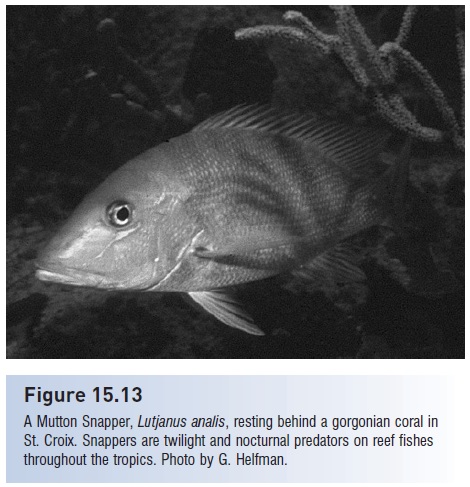
Figure 15.13
A Mutton Snapper, Lutjanus analis, resting behind a gorgonian coral inSt. Croix. Snappers are twilight and nocturnal predators on reef fishesthroughout the tropics. Photo by G. Helfman.
A subsequent group of families (lutjanids through nemipterids)consists of generally heavy-bodied, tropical fishes that swim near the bottom and feed on large invertebratesand fishes (with some notable exceptions). The lutjanids are a large family (105 species) of ecologically diverse but generally carnivorous marine fishes inhabiting shallow tomoderate depths in tropical and warm temperate seas andestuaries (e.g., Polovina & Ralston 1987). The typicalsnapper is a fairly large (up to 1 m), heavy-bodied, suprabenthic, nocturnal or crepuscular predator with large canineteeth, such as the Gray, Red, Mangrove, or Mutton snappers(Lutjanus spp.,Pristopomoides spp.) (Fig. 15.13).However, many snappers live in the water column and aremore streamlined, including the Vermilion and Yellowtailsnappers (Rhomboplites, Ocyurus). A closelyrelated family,the caesionid fusiliers, are small, streamlined, and brilliantlycolored planktivores with forked tails andprotrusiblemouths that school near drop-offs and reef edges on coralreefs of the Indo-West Pacific. Lobotid tripletails get theirname from the unusual arrangement of soft dorsal, soft anal, and caudal fins of nearly equal size and roundedshape, the dorsal and anal fins placed posteriorly on thebody overlapping the tail fin. Tripletails are heavy-bodied,basslike fishes of estuarine and fresh waters worldwide intemperate and tropical waters. Adults can reach a meter in length and are uncommon; juveniles are more frequently encountered floating leaflike on their sides in mangroveregions. The silverymojarras (Gerreidae) are common in habitants of sandy or silty regions near coral reefs and other shallow, warm water habitats worldwide; some species enter fresh water. Their body shape and feeding habits are somewhat incongruous. They have a forked tail and mouth that protrudes slightly downwards, which mightsuggest zooplanktivory, but they are typically observed foraging head-down with their extremely protractile mouthsextended into the bottom sediments. When they emerge they typically expel clouds of sediment out their gill openings,having retained benthic invertebrates with their gillrakers.
Grunts (Haemulidae) are moderate-sized coral reef fishesthat are unusual in that they are more diverse in the Newrather than the Old World tropics. Most grunts form shoalsas juveniles and some such as the porkfish, Anisotremus,which is common in the Florida Keys, continue to shoal asadults. They are typically nocturnal feeders on benthic orgrassbed associated invertebrates, undertaking distinctivemigrations between daytime resting and nighttime feedingregions. The inermiid bonnetmouths arehaemulid derivatives adapted for zooplanktivorous feeding.They have the slender bodies, forked tails, and protractilemouths typical of many zooplanktivorous fishes. Porgies(Sparidae) are gruntlike in appearance but are more diversify ed in their feeding than the haemulids. The western Atlantic Sheepshead, Archosargus probatocephalus, has massivepharyngeal dentition used for crushing hard-bodied preysuch as mollusks. Several sparids, such as the Pinfish, Lagodon rhomboides, feed extensively on plants, makingthis one of the few percoid families to include stronglyherbivorous species (herbivory becomes more common inmore advanced groups). Together with the centracanthids, lethrinids, and nemipterids, the porgies form a superfamilyof related families known as sparoids; the sparids are the only family in the group in the western Atlantic region.
The next three families contain fishes that are frequently seen swimming just above and probing into the bottomwith modified appendages. Polynemid thread fins are tropicalmarine fishes with highly specialized pectoral fins thatare divided into two parts. The upper webbed portion islocated laterally and shaped like a normal pectoral fin,whereas the ventral portion consists of three to seven long,unconnected rays that extend down from the throat regionand are used to feel for prey on the bottom. The mouth is subterminal, as befits a bottom feeder. Some sciaenid croakersand drums also have a subterminal mouth. Many specieshave one or several small chin barbels. Sciaenids are a wide spread tropical and temperate family and are particularlydiverse in the southeastern USA. This large family(270 species) includes such important commercial andsportfishes as the Red Drum (spot tail bass), Black Drum,croakers, weakfish, sea trouts, kingfishes, White Seabass, corbinas, and the endangered Mexican Totoaba and Chinese Bahaba (the last two species can exceed 100 kg in mass).The common names for the family come from sound production habits that involve the vibration of muscles attachedto the gas bladder. As is frequently the case with soundproducingfishes, sciaenid otoliths are exceptionally large.The role of acoustic stimuli in the biology of sciaenids is also reflected in their very extensive lateral line, whichextends posteriorly onto the tail and anteriorly as numerouspits and canals on the head. Although a predominantlymarine family, freshwater species are common in South America, and one species, the Freshwater Drum, Aplodinotusgrunniens, may have the largest natural latitudinal range of any freshwater fish, occurring throughout the MississippiRiver and adjacent drainages of North America and into Central America, from southern Saskatchewan and Quebecto Guatemala. The third bottom-oriented family consists ofthe mullidgoatfishes. This tropical family of medium-sized,nearshore marine predators has two highly prehensile chinbarbels that the fishes use to probe bottom sediments forprey. Their foraging activities frequently flush invertebratesfrom the sand and it is not unusual to see wrasses andcarangids following goatfishes and capturing escapees.
Monodactylid fingerfishes and toxotid archerfishes arebrackish water families of chiefly Indo-Pacific distribution.The monodactylids, or monos, are popular aquarium fishes.Their silvery-white, laterally compressed bodies are exaggeratedby extremely tall dorsal and anal fins, making some species twice as deep as they are long. Adult Monodactyluslack a pelvic fin, although juveniles possess one. They are convergent in shape and ontogenetic pelvic loss with the very compressed carangid Germanfish,Parastromateusniger. The archerfishes are a well-known and unique group of small, surface-dwelling estuarine and freshwater fishes that feed actively on terrestrial prey. Insects are shot out of overhanging vegetation with bullets of water produced by compressing the gillcovers and shooting water dropsalong a groove created by the tongue and palate. This behavior is all the more fascinating because the fish corrects for the curving trajectory of its propelled droplets and target movement as well as for light refraction at the water’s surface, its eyes being submerged during hunting(Dill 1977a; Schuster et al. 2006). Kyphosid sea chubs (alsocalled rudderfishes) are an herbivorous family of 42 reefspecies that swim actively in shoals relatively high abovethe reef compared to most other herbivores. Kyphosids areunique among fishes in that at least two western Australian species contain symbiotic bacteria in their guts that breakdown algae via fermentation (Rimmer & Wiebe 1987).Although a predominantly tropical family, two temperatederivative species, the Opaleye, Girella nigricans, and theHalfmoon, Medialuna californica, extend into Californiawaters.
Some authors feel that the kyphosids, monodactylids,and toxotids form, with the next five or so families, an unranked group known as the Squammipinnes, a name thatrefers to the rows of scales that cover the base of the dorsaland anal fins. The best known families in this group are the butterflyfishes and angelfishes. The chaetodontid butterflyfishes include 122 tropical shallow water species. Theircenter of diversity is in the Indo-Pacific region where about100 of the species occur. The tropical Atlantic contains 13species and the eastern Pacific has only four species. Inmany people’s minds, butterflyfishes are synonymous withcoral reefs (Burgess 1978; Motta 1989), and their presenceand abundance is proposed as a measure of the health ofcoral reef habitats (Ohman et al. 1998).Butterflyfishes arecolorful and swim conspicuously about the reef during thedaytime, often in pairs or small shoals, residing for longperiods on the same reefs and with the same partners. Trophically they fall into several categories of microconsumers, feeding either on coral polyps, small invertebrateshidden in crevices in the reef, tube worms, or on zooplankton.Anatomically they are deep-bodied, highly compressed forms, their body shape being exaggerated by stout dorsal,pelvic, and anal spines and a slightly to greatly elongatedsnout region. Closely related to and often mistaken for butterflyfishes are the similarly or larger sized angelfishes
(Pomacanthidae). A major distinguishing feature between the two is the existence of a stout, posteriorly projecting spine at the angle of the preopercular bone and the absence of a pelvic axillary process in angelfishes. Many angelfishes undergo dramatic ontogenetic color changes, several species having confusingly similar but striking patterns as juvenilesthat change to species specific and still-striking adult patterns.Larger species such as the Caribbean French andGray angelfishes frequently form pairs. Trophically, angelfishes differ from butterflyfishes in consuming sessile, benthic invertebrates such as sponges, tunicates, and anthozoans. Some species are known to follow sea turtles and feed on their feces, which mayexplain their disconcerting habit of hovering near designated latrines associated with undersea habitats such as Tektite and Hydrolab, before such submarine structures had internal plumbing. Again,about three-quarters of angelfish species occur in the Indo-Pacific. Angelfishes are among the few marine speciesin which hybrids are frequently discovered (e.g., Pyle & Randall 1994).
Most of the remaining families in the suborder Percoidea are relatively small. Among the more speciose groups are the nandid and closely related polycentrid leaffishes of South American, African and southern Asian fresh waters,which are best known for their striking morphological resemblance to floating leaves, a deception they enhancebehaviorally by drifting slowly through the water toward unsuspecting prey, which they engulf with a remarkably expandable mouth. Terapontid grunters are a marine and freshwater family containing 48 species that have a uniquemeans of producing sounds. Paired muscles run from theback of the skull to the dorsal surface of the gas bladder;in other sound-producing fishes that utilize muscles tovibrate the gas bladder, such as gadoids, triglids, and sciaenids, the muscles are derived from trunk musculature and originate in the body wall. Kuhliid fl agtails are predominantly marine and estuarine inhabitants but some species have evolved to fill ecological niches in freshwater habitatson oceanic islands.
Five subsequent families are placed in the superfamily Cirrhitoidea, united by elongated and unbranched lower five to eight rays in their pectoral fins. The colorful cirrhitid hawk fishes are small to medium reef predators that are best known for sitting absolutely still on tops of corals in seemingly conspicuous locales, waiting for potential prey fishes to either not notice them or to habituate to their presence(a Hawaiian hawkfish is the only predator known to have eaten a Cleaner Wrasse). Hawk fishes look like a cross between a small seabass and a scorpionfish, but they are readily identified by the presence of filamentous tufts orcirri at the top of each spine in the first dorsal fin and by the elongated pectoral rays characteristic of the super family. One fairly deep water reef species, the Longsnout Hawkfish, Oxycirrhites typus, occurs almost exclusively in black coraltrees. Its deep water habits may more closely reflect depletion of its preferred perch, which has been removed fromaccessible shallow locations due to the jewelry trade. The next to last family of percoids are the cepolid bandfishes,which vary in their morphology from elongate, eel-like forms to fairy basslet like, deep water forms.
The barracudas (Sphyraenidae) appear to be percoids, although some morphological data suggest that they are primitive, basal members of the Scombroidei, the suborder that contains the tunas (Orrell et al. 2006). Twenty-one species of barracuda inhabit tropical and subtropical regions of the Atlantic, Pacific, and Indian oceans. Most barracudas are schooling predators, an important exception being the usually solitary Great Barracuda, Sphyraena barracuda(Paterson 1998). Great barracuda approach 2 m in length(a topic of considerable controversy), have fang like, fl attened teeth capable of slicing cleanly through most prey,and have the unnerving habit of following divers around the reef, motivated by either curiosity or territoriality (Fig.15.14; see also Fig. 19.1).
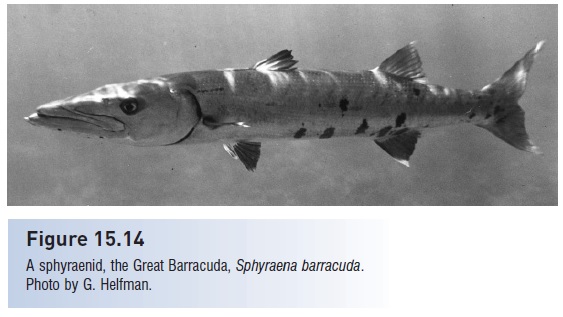

Related Topics